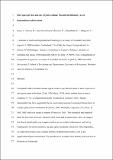Files in this item
How apes get into and out of joint actions : shared intentionality as an interactional achievement
Item metadata
| dc.contributor.author | Genty, Emilie | |
| dc.contributor.author | Heeson, Raphaela | |
| dc.contributor.author | Guery, Jean-Pascal | |
| dc.contributor.author | Zuberbühler, Klaus | |
| dc.contributor.author | Bangerter, Adrian | |
| dc.date.accessioned | 2021-02-23T13:30:06Z | |
| dc.date.available | 2021-02-23T13:30:06Z | |
| dc.date.issued | 2021-02-09 | |
| dc.identifier | 266096240 | |
| dc.identifier | 6b437b2e-ebef-4dcc-b243-fc1201c14116 | |
| dc.identifier | 85100941166 | |
| dc.identifier | 000617053300003 | |
| dc.identifier.citation | Genty , E , Heeson , R , Guery , J-P , Zuberbühler , K & Bangerter , A 2021 , ' How apes get into and out of joint actions : shared intentionality as an interactional achievement ' , Interaction Studies , vol. 21 , no. 3 , pp. 353-386 . https://doi.org/10.1075/is.18048.gen | en |
| dc.identifier.issn | 1572-0373 | |
| dc.identifier.other | ORCID: /0000-0001-8378-088X/work/89178194 | |
| dc.identifier.uri | https://hdl.handle.net/10023/21488 | |
| dc.description.abstract | Compared to other animals, humans appear to have a special motivation to share experiences and mental states with others (Clark, 2006; Grice, 1975), which enables them to enter a condition of ‘we’ or shared intentionality (Tomasello & Carpenter, 2005). Shared intentionality has been suggested to be an evolutionary response to unique problems faced in complex joint action coordination (Levinson, 2006; Tomasello, Carpenter, Call, Behne, & Moll, 2005) and to be unique to humans (Tomasello, 2014). The theoretical and empirical bases for this claim, however, present several issues and inconsistencies. Here, we suggest that shared intentionality can be approached as an interactional achievement, and that by studying how our closest relatives, the great apes, coordinate joint action with conspecifics, we might demonstrate some correlate abilities of shared intentionality, such as the appreciation of joint commitment. We provide seven examples from bonobo joint activities to illustrate our framework. | |
| dc.format.extent | 16951591 | |
| dc.language.iso | eng | |
| dc.relation.ispartof | Interaction Studies | en |
| dc.subject | Shared intentionality | en |
| dc.subject | Jjoint action | en |
| dc.subject | Coordination | en |
| dc.subject | Joint commitment | en |
| dc.subject | Language | en |
| dc.subject | Great apes | en |
| dc.subject | Bonobos | en |
| dc.subject | Chimpanzees | en |
| dc.subject | BF Psychology | en |
| dc.subject | I-PW | en |
| dc.subject.lcc | BF | en |
| dc.title | How apes get into and out of joint actions : shared intentionality as an interactional achievement | en |
| dc.type | Journal article | en |
| dc.contributor.institution | University of St Andrews. School of Psychology and Neuroscience | en |
| dc.identifier.doi | https://doi.org/10.1075/is.18048.gen | |
| dc.description.status | Peer reviewed | en |
| dc.date.embargoedUntil | 2021-02-09 |
This item appears in the following Collection(s)
Items in the St Andrews Research Repository are protected by copyright, with all rights reserved, unless otherwise indicated.

